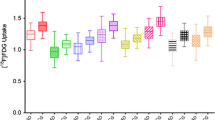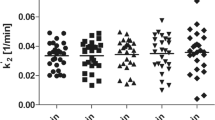Abstract
Objective
In clinical cerebral 2-[18F]fluoro-2-deoxy-d-glucose positron emission tomography (FDG-PET) studies, we sometimes encounter hyperglycemic patients with diabetes mellitus or patients who have not adhered to the fasting requirement. The objective of this study was to investigate the influence of mild hyperglycemia (plasma glucose range 110–160 mg/dl) on the cerebral FDG distribution patterns calculated by statistical parametric mapping (SPM).
Methods
We studied 19 healthy subjects (mean age 66.2 years). First, all the subjects underwent FDG-PET scans in the fasting condition. Then, 9 of the 19 subjects (mean age 64.3 years) underwent the second FDG-PET scans in the mild hyperglycemic condition. The alterations in the FDG-PET scans were investigated using SPM-and region of interest (ROI)-based analyses. We used three reference regions: (1) SPM global brain (SPMgb) used for SPM global mean calculation, (2) the gray and white matter region computed from magnetic resonance image (MRIgw), and (3) the cerebellar cortex (Cbll).
Results
The FDG uptake calculated as the standardized uptake value (average) in SPMgb, MRIgw, and Cbll regions in the mild hyperglycemic condition was 42.7%, 41.3%, and 40.0%, respectively, of that observed in the fasting condition. In SPM analysis, the mild hyperglycemia was found to affect the cerebral distribution patterns of FDG. The FDG uptake was relatively decreased in the gray matter, mainly in the frontal, temporal, and parietal association cortices, posterior cingulate, and precuneus in both SPMgb-and MRIgw-reference-based analyses. When Cbll was adopted as the reference region, those decrease patterns disappeared. The FDG uptake was relatively increased in the white matter, mainly in the centrum semiovale in all the reference-based analyses.
Conclusions
It is noteworthy that the FDG distribution patterns were altered under mild hyperglycemia in SPM analysis. The decreased uptake patterns in SPMgb-(SPM default) and MRIgw-reference-based analyses resembled those observed in Alzheimer’s disease. Under mild hyperglycemia, we can recommend Cbll as the reference region to detect decreased uptake patterns. We should pay special attention to controlling the diet condition, monitoring hyperglycemia, and optimizing the reference region in SPM analysis, particularly in the diagnosis of early Alzheimer’s disease in clinical FDG-PET.
Similar content being viewed by others
References
Vander Borght T, Laloux P, Maes A, Salmon E, Goethals I, Goldman S. Guidelines for brain radionuclide imaging: perfusion single photon computed tomography (SPECT) using Tc-99m radiopharmaceuticals and brain metabolism positron emission tomography (PET) using F-18 fluorodeoxyglucose. Acta Neurol Belg 2001;101:196–209.
Bartenstein P, Asenbaum S, Catafau A, Halldin C, Pilowski L, Pupi K, et al. European Association of Nuclear Medicine procedure guidelines for brain imaging using [18F]FDG. Eur J Nucl Med Mol Imaging 2002;29:43–48.
Signorini M, Paulesu E, Friston K, Perani D, Colleluori A, Lucignani G, et al. Rapid assessment of regional cerebral metabolic abnormalities in single subjects with quantitative and nonquantitative [18F]FDG PET: a clinical validation of statistical parametric mapping. Neuroimage 1999;9:63–80.
Minoshima S, Frey KA, Koeppe RA, Foster NL, Kuhl DE. A diagnostic approach in Alzheimer’s disease using three-dimensional stereotactic surface projections of fluorine-18-FDG PET. J Nucl Med 1995;36:1238–1248.
Sokoloff L, Reivich M, Kennedy C, Des Rosiers MH, Patlak CS, Pettigrew KD, et al. The [14C]deoxyglucose method for the measurement of local cerebral glucose utilization: theory, procedure, and normal values in the conscious and anesthetized albino rat. J Neurochem 1977;28:897–916.
Hasselbalch SG, Knudsen GM, Capaldo B, Postiglione A, Paulson OB. Blood-brain barrier transport and brain metabolism of glucose during acute hyperglycemia in humans. J Clin Endocrinol Metab 2001;86:1986–1990.
Meyer JH, Gunn RN, Myers R, Grasby PM. Assessment of spatial normalization of PET ligand images using-specific templates. Neuroimage 1999;9:545–553.
Benson DF, Kuhl DE, Hawkins RA, Phelps ME, Cummings JL, Tsai SY. The fluorodeoxyglucose 18F scan in Alzheimer’s disease and multi-infarct dementia. Arch Neurol 1983;40:711–714.
Friedland RP, Brun A, Budinger TF. Pathological and positron emission tomographic correlations in Alzheimer’s disease. Lancet 1985;1:228.
Duara R, Grady C, Haxby J, Sundaram M, Cutler NR, Heston L, et al. Positron emission tomography in Alzheimer’s disease. Neurology 1986;36:879–887.
Rapoport SI, Horwitz B, Grady CL, Haxby JV, DeCarli C, Schapiro MB. Abnormal brain glucose metabolism in Alzheimer’s disease, as measured by position emission tomography. Adv Exp Med Biol 1991;291:231–248.
Fukuyama H, Ogawa M, Yamauchi H, Yamaguchi S, Kimura J, Yonekura Y, et al. Altered cerebral energy metabolism in Alzheimer’s disease: a PET study. J Nucl Med 1994;35:1–6.
Minoshima S, Foster NL, Kuhl DE. Posterior cingulate cortex in Alzheimer’s disease. Lancet 1994;344:895.
Minoshima S, Giordani B, Berent S, Frey KA, Foster NL, Kuhl DE. Metabolic reduction in the posterior cingulate cortex in very early Alzheimer’s disease. Ann Neurol 1997;42:85–94.
Bartlett EJ, Brodie JD, Wolf AP, Christman DR, Laska E, Meissner M. Reproducibility of cerebral glucose metabolic measurements in resting human subjects. J Cereb Blood Flow Metab 1988;8:502–512.
Maquet P, Dive D, Salmon E, von Frenckel R, Franck G. Reproducibility of cerebral glucose utilization measured by PET and the [18F]-2-fluoro-2-deoxy-d-glucose method in resting, healthy human subjects. Eur J Nucl Med 1990;16:267–273.
Wang GJ, Volkow ND, Overall J, Hitzemann RJ, Pappas N, Pascani K, et al. Reproducibility of regional brain metabolic responses to lorazepam. J Nucl Med 1996;37:1609–1613.
Tyler JL, Strother SC, Zatorre RJ, Alivisatos B, Worsley KJ, Diksic M, et al. Stability of regional cerebral glucose metabolism in the normal brain measured by positron emission tomography. J Nucl Med 1988;29:631–642.
Phelps ME, Huang SC, Hoffman EJ, Selin C, Sokoloff L, Kuhl DE. Tomographic measurement of local cerebral glucose metabolic rate in humans with (F-18)2-fluoro-2-deoxy-d-glucose: validation of method. Ann Neurol 1979;6:371–388.
Reivich M, Alavi A, Wolf A, Fowler J, Russell J, Arnett C, et al. Glucose metabolic rate kinetic model parameter determination in humans: the lumped constants and rate constants for [18F]fluorodeoxyglucose and [11C]deoxyglucose. J Cereb Blood Flow Metab 1985;5:179–192.
Tataranni PA, Gautier JF, Chen K, Uecker A, Bandy D, Salbe AD, et al. Neuroanatomical correlates of hunger and satiation in humans using positron emission tomography. Proc Natl Acad Sci USA 1999;96:4569–4574.
Routh VH. Glucose-sensing neurons: are they physiologically relevant? Physiol Behav 2002;76:403–413.
Pardridge WM, Boado RJ, Farrell CR. Brain-type glucose transporter (GLUT-1) is selectively localized to the blood-brain barrier: studies with quantitative western blotting and in situ hybridization. J Biol Chem 1990;265:18035–18040.
Maher F, Vannucci SJ, Simpson IA. Glucose transporter proteins in brain. FASEB J 1994;8:1003–1011.
Nagamatsu S, Sawa H, Kamada K, Nakamichi Y, Yoshimoto K, Hoshino T. Neuron-specific glucose transporter (NSGT): CNS distribution of GLUT3 rat glucose transporter (RGT3) in rat central neurons. FEBS Lett 1993;334:289–295.
Asano T, Katagiri H, Takata K, Tsukuda K, Lin JL, Ishihara H, et al. Characterization of GLUT3 protein expressed in Chinese hamster ovary cells. Biochem J 1992;288:189–193.
Yano H, Seino Y, Inagaki N, Hinokio Y, Yamamoto T, Yasuda K, et al. Tissue distribution and species difference of the brain type glucose transporter (GLUT3). Biochem Biophys Res Commun 1991;174:470–477.
Ito H. The summary of “Treatment guidelines of diabetes mellitus in the elderly people” drafted by a group of comprehensive research on aging and health (in Japanese). Geriatric Med 1996;34:899–902.
Author information
Authors and Affiliations
Corresponding author
Rights and permissions
About this article
Cite this article
Kawasaki, K., Ishii, K., Saito, Y. et al. Influence of mild hyperglycemia on cerebral FDG distribution patterns calculated by statistical parametric mapping. Ann Nucl Med 22, 191–200 (2008). https://doi.org/10.1007/s12149-007-0099-7
Received:
Accepted:
Published:
Issue Date:
DOI: https://doi.org/10.1007/s12149-007-0099-7




